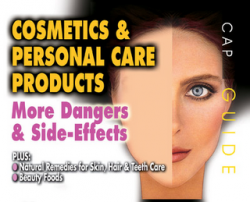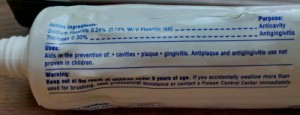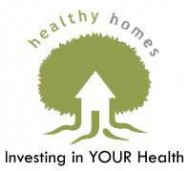
by JuneMary | Dec 14, 2015 | All Renewed Health Articles, Health Hazards, Healthy Living, Personal Care |
Where this information comes from and why we should avoid products which contain them.
The skin is the quickest route for absorption of chemicals into the bloodstream – undiluted – hence nicotine and HRT patches.
CAP (Consumer’s Association of Penang – Malaysia) have published a booklet detailing the findings of their ground-breaking study to reveal “Cancer-Causing chemicals in Cosmetics and Daily Use Products”
CAP’s study was prompted by a 496% increase in the number of reported cancer cases which rose from 6,254 in 1970 to 37,294 in 1996 – during which time Malasian society was becoming “modernised” in the mould of Western Societies. Their death rate from cancer had risen to match ours in the UK – 103 a day!
Below are some of the chemicals they named: (You will find a more complete list here https://www.facebook.com/groups/1689356897948626/files/ )
Sodium lauryl sulphate (SLS)
– It is a mutagen (it can alter the DNA). Found in toothpaste, body & facial washes. Made from coconut oil – industrial degreaser for engines and garage floors. It denatures protein so it damages the mucosal lining of the mouth and vagina making them susceptible to infections – ulcers, urinary tract, bladder & kidney infections
Sodium laureth sulphate (SLES)
SLES was used to make Agent Orange to defoliate the trees during the Vietnam war and large numbers of veterans have died or are dying from various kinds of cancer.
It is also found in children’s bubble bath as it creates more bubbles. It is even more dangerous than SLS. Research has shown that it prevents proper development of the eyes in young mammals and causes cataracts in older people.
Propylene glycol
Found in baby wipes and moisturisers, it is also the main ingredient in brake fluid and anti-freeze. It sits on the skin’s surface producing the “plastic bag” effect –the skin cannot respire–but it feels smooth and healthy. It is, in fact, drawing water from up from the living cells, thus damaging them.
Mineral oil
Found in moisturisers. (Alias Petroleum, Petrolatum, Paraffin, Paraffin Oil, Parafinium Liquidium)
Fluoride
Found in toothpaste. Sodium Monofluorophosphate, better known as Sodium Fluoride is used to make rat poison and is also used as an insecticide for ants and cockroaches.
This is a waste product from the phosphate fertilizer industry, a poison similar to cyanide, known to cause very dense brittle bones and dental fluorosis – the first visible sign of fluoride poisoning.
It is so corrosive that it is transported in glass-lined tankers.
A 1997 survey found that the average person who brushes his/her teeth with a pea-sized amount of fluoridated toothpaste ingests between 0.3 and 0.4mg of fluoride each time they brush – almost half our daily tolerable limit of fluoride.
It is also added to drinking water and school milk in certain areas of the UK.
It is also called fluorosilicic acid.
See the National Pure Water Association website for more details: www.npwa.org.uk
Saccharin
Found in mouthwashes. Derived from coal tar. This caused bladder cancer in animal studies and research shows that it promotes the cancer-causing effects of other carcinogens. It is used as an artificial sweetener and can also be found in processed foods.
Ethanol
Type of alcohol from petroleum. Mouthwashes typically contain higher concentrations of alcohol than beer and wine. An alcohol content of 25% has been implicated in mouth, tongue and throat cancers. It has a similar effect on mouth tissues as SLS.
Formaldehyde
Used to embalm the dead.
Found in deodorant, shampoo, mouthwash, toothpaste, nail polish, aftershave, perfume. Causes cancer in animals and suspected of causing it in humans.
Aluminium salts
In all anti-perspirants. They block the sweat glands. (A bad idea as it traps toxins inside the body because the lymph can’t move either so it is implicated in breast cancer). Linked to brain disorders such as dementia, Alzheimer’s, behaviour abnormalities, impaired poor memory, impaired visual-motor co-ordination.
Talcum powder (Talc)
Baby Powder, cosmetics. It is the same molecular structure as asbestos. Causes cancer. Keep away from female genital area. Do not breathe it in.
The AUDIO MP3 here “Exposing the Lies ….” is in addition to the above.
You can purchase safe products by joining Here.

by JuneBHse | Dec 10, 2015 | All Renewed Health Articles, Health Hazards, Healthy Living, Optimum Health Topics, Personal Care |
We are all familiar with the saying “It’s the final straw that breaks the camel’s back.”

Healthy Home
Today that saying is applicable to our well-being, the “straws” being all the factors which are causing our bodies to suffer “dis-ease” and which range from poor nutrition and toxicity to being stuck in a traffic jam every day.
Some things we have no control over but we can take control of others and the more “straws” we can remove, the better for us and for our well-being.
One “straw” that we can remove, thus lifting an unnecessary burden from our lives, is the daily poisoning of our bodies and homes.
For toxin-free, high performance products
click here https://www.modere.eu/?referralCode=994155
Over the last few years, ordinary people, i.e. non-scientists like you and me, have become increasingly aware of the dangers posed by man-made chemical ingredients in products we use every day at home. Two TV programmes “How Toxic are You?” and “How Toxic are Your Kids?” enhanced this awareness, so I decided to take this opportunity to share with you what I have learned.
I firmly believe that everyone has the right to make choices. To do this effectively, we need knowledge.
It’s hard to believe that the most dangerous place is inside our own home.
A 15 year study showed that “women who worked at home had a 54% higher death rate from cancer than women who had jobs elsewhere.”
In 1989, a study by the US Dept of Occupational Safety and Health showed that of 2,983 chemicals used in personal and household products:
- 884 were known to be toxic. Of these:
- 778 were acutely toxic
- 146 were carcinogenic
- 218 were believed to cause reproductive complications
- 314 were believed to cause biological mutations
- 376 were known to cause eye and skin irritation
In 2003, a “ContamiNATION” study by the World Wide Foundation found as many as 70 different chemicals in the blood of UK citizens.
- The average number was 27 with one poor man having 49.
- Babies were being born with as many as 20.
- Toxins tend to be stored in the fat. The implication is that mothers are passing on toxins in their breast milk.
Household products release toxic vapours even when they are not being used. We don’t need our eyes to tell us where the washing powders and cleaning products are in the supermarket, do we?
Then there are the air fresheners. Do you know it takes at least 100 chemicals to make a “perfume”? Have you ever read the warnings on the back? Nasty!
“Most homes have airborne concentrations of hazardous and toxic chemicals 2 to 5 times higher indoors than outside. Some homes are 70 times higher!” (US Environmental Protection Agency 1989)
Have £10 off your first order https://www.modere.eu/?referralCode=994155
The most common ingredients to watch out for in personal care products are these (although there are more than 100 alternative names for the first one!):-
- Sodium Lauryl/Laureth Sulphate – corrosive industrial degreaser. Affects the eyes and the lining of the mouth, can alter DNA. (foaming products)
- Propylene Glycol – anti-freeze, brake fluid (moisturisers, baby wipes)
- Aluminium Salts – block the sweat glands trapping toxins inside (implicated in breast cancer). Also linked to brain disorders (anti-perspirants)
- Talc – similar molecular structure to asbestos (cosmetics)
(You will find a more comprehensive list to print out in the DOWNLOADS/Audio section so you can check your cupboards.)
An added complication is “potentially” harmful ingredients.
A lot of chemicals are safe until mixed with something else e.g. Triclosan and water = toxic dioxins.
So why is it in toothpaste??
Thousands of ingredients used in the household have never been tested, so no-one knows whether they are safe or not.
Well that’s the BAD NEWS…
Some GOOD NEWS is that…
….just as not all natural substances are safe, not all chemicals are harmful. In fact, some are very beneficial.
The trick is knowing which is which.
And, here’s the REALLY GOOD NEWS…
Safe, affordable products….https://www.modere.eu/?referralCode=994155
Someone I know told me about a Safety-Conscious company who do know the difference.
So now we can take out the guess work by buying the full range of effective every-day-use products from the company who, more than 25 years ago, pioneered the formulation, manufacture and distribution of products where more than 3000 commonly-used ingredients are avoided because they are known to be harmful or have a question mark over them.
I have transferred my spending on my personal and household products to them. You can too.
You don’t have to go and find your products and carry them home. You can order by phone or on-line and they will be delivered to your door.
Do you want the benefits of a Healthy Home?
Open your own Account here:-
https://www.modere.eu/?referralCode=994155
You will receive a discount of £10 at the checkout and if your purchases come to £79 after the discount, you will receive free carriage too.
There are other benefits for you too. Check out “Share the Love” 🙂
Please contact me with any questions. I’m happy to help you get the best from your choices.






